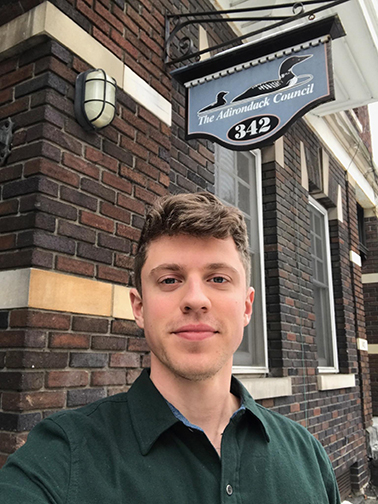
Celebrating the 125th Birthday of the Adirondack Park: The Park Grows Up!
May 18, 2017
Kyle Plaske - Adirondack Council Clarence Petty Intern- Albany Office
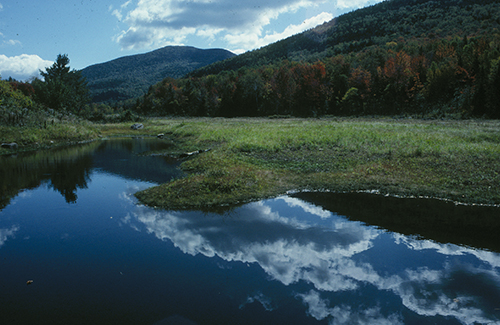 As we touched on in Part 1 of our blog celebrating the Adirondack Park’s 125th birthday, while the legislation that created the Adirondack Park was a great moment in history, it left the state-owned Forest Preserve within the Blue Line largely unprotected. In fact, the same legislation the created the Adirondack Park repealed the ban on the sale of Forest Preserve lands, which was enacted by the Legislature in 1885 with the creation of the Forest Preserve. Fortunately, New Yorkers had the foresight to realize that these lands still needed protection. This led to the adoption of what is now known as Article XIV of New York State’s Constitution: the “Forever Wild” clause.
As we touched on in Part 1 of our blog celebrating the Adirondack Park’s 125th birthday, while the legislation that created the Adirondack Park was a great moment in history, it left the state-owned Forest Preserve within the Blue Line largely unprotected. In fact, the same legislation the created the Adirondack Park repealed the ban on the sale of Forest Preserve lands, which was enacted by the Legislature in 1885 with the creation of the Forest Preserve. Fortunately, New Yorkers had the foresight to realize that these lands still needed protection. This led to the adoption of what is now known as Article XIV of New York State’s Constitution: the “Forever Wild” clause.
While not discussed as a reason to hold New York State’s Constitutional Convention in 1894, the appeal of the Forever Wild clause, known then as the Forestry Amendment, was immediately apparent, and delegates flocked to support it.
In his 1921 book A History of the Adirondacks, historian Alfred L. Donaldson explains: “the [Amendment] was cordially welcomed by the entire convention. Even the delegates from the wooded regions of 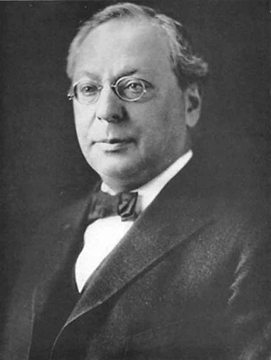
Louis Marshallthe Adirondacks, whose opposition had been reasonably expected, gave it the most ungrudging support. One delegate, E.A. Brown, summed up the general feelings on the Amendment: “Unless you want this great water supply, this great sanitarium, this great health resort . . . destroyed, you must shut the door, and you must close it tight, and close it right away.”
The Amendment was introduced by delegates from New York City, and this was not a coincidence. The City had much to lose from ongoing deforestation and the depletion of the state’s watershed in the Adirondack Park. The New York Board of Transportation and Trade quickly threw its considerable weight behind the measure.
Significant support came from New York City delegate Louis Marshall, a prominent constitutional lawyer and civil rights advocate. His sons Bob, George and James would also go on to join the conservation struggle, with all three later becoming co-founders of The Wilderness Society. (Members of the Marshall family have volunteered to serve on the Adirondack Council’s Board of Directors since its founding in 1975).
.jpg) On September 13, 1894, the Forestry Amendment was approved by a vote of 122-0, the only proposed amendment to garner unanimous support among convention delegates. The proposed Article 7, Section 7 read: “The lands of the state, now owned or hereafter acquired, constituting the Forest Preserve as now fixed by law, shall be forever kept as wild forest lands. They shall not be leased, sold or exchanged, or be taken by any corporation, public or private, nor shall the timber thereon be sold, removed or destroyed.”
On September 13, 1894, the Forestry Amendment was approved by a vote of 122-0, the only proposed amendment to garner unanimous support among convention delegates. The proposed Article 7, Section 7 read: “The lands of the state, now owned or hereafter acquired, constituting the Forest Preserve as now fixed by law, shall be forever kept as wild forest lands. They shall not be leased, sold or exchanged, or be taken by any corporation, public or private, nor shall the timber thereon be sold, removed or destroyed.”
The Forever Wild Clause has since been renumbered to Article XIV, Section 1 in New York State’s Constitution, and it has been repeatedly challenged nearly every year since its inception, but its wording has not changed. Over 150 attempts have been made to repeal or weaken Article XIV, but only a few exceptions have been allowed…authorized by the Constitutional Amendment process and approved by voters. Throughout the years, voters have approved the removal of parcels from the Forest Preserve for specific reasons, in exchange for lands of greater value being added back to the Preserve. The Constitutional amendments include land exchanges for municipal water wells, emergency power lines, airport runway safety, state ski areas, and state highways.
Following the adoption of the Forever Wild clause, the defunct Fores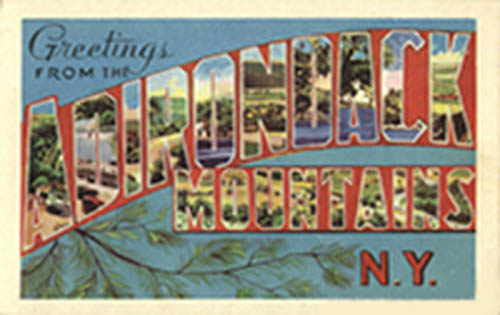 t Commission, which had failed to keep its watchful eye on the Forest Preserve, was abolished and replaced with the Forest, Fish and Game Commission. This was later renamed the Conservation Commission and was tasked with administration of the Forest Preserve. In 1970, the Conservation Commission would be reorganized and renamed the Department of Environmental Conservation (DEC) and today it administers the state’s environmental laws, regulates hunting and fishing, and manages the Forest Preserve, other state forest lands and state-owned campgrounds.
t Commission, which had failed to keep its watchful eye on the Forest Preserve, was abolished and replaced with the Forest, Fish and Game Commission. This was later renamed the Conservation Commission and was tasked with administration of the Forest Preserve. In 1970, the Conservation Commission would be reorganized and renamed the Department of Environmental Conservation (DEC) and today it administers the state’s environmental laws, regulates hunting and fishing, and manages the Forest Preserve, other state forest lands and state-owned campgrounds.
While the publicly-owned Forest Preserve was being protected by New York’s Constitution, the construction of the Adirondack Northway in 1967 demonstrated that stronger protections for the private lands of the Adirondack Park were needed. The Northway brought previously remote areas of the Park within the reach of tourists flocking to the Adirondacks for their beauty and recreational opportunities. Soon, hotels, bars, gas stations, and general stores sprang up to meet the demand. Private lands of the Park that had few or no land-use controls were suddenly under immense development pressure. This uncontrolled development was troubling for many who saw the wild character of the region being threatened yet again by the unregulated influx of business interests.
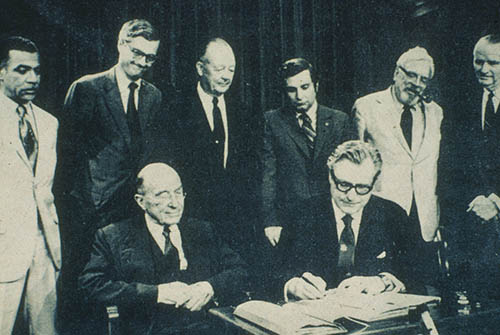
Adirondack Park Agency Act being signed
by NYS Governor Rockefeller
In an effort to protect the private lands in the Adirondacks, Laurance Rockefeller proposed establishing the Adirondack Mountains National Park. It was a failed attempt as it was widely unpopular with the Park’s residents and visitors alike. However, it did lead to Governor Nelson Rockefeller proposing the creation of a state agency that would develop long-range land-use plans to protect both the public and private lands in the Adirondack Park. In 1971, the State Legislature passed legislation creating the Adirondack Park Agency (APA).
In 1972, the APA created two master plans for land use in the Adirondack Park: one for public lands and one for private lands. The Adirondack Park State Land Master Plan (SLMP) was met with near unanimous approval. It laid out a comprehensive classification system for state land use within the Blue Line based on the unique characteristics and carrying capacity of specific tracts of land. For example, the Wilderness classification bans the use of motorized and mechanized vehicles, which remains the strictest classification in the SLMP.
On the contrary, the APA’s Private Land Use and Development Plan (PLUDP) was not met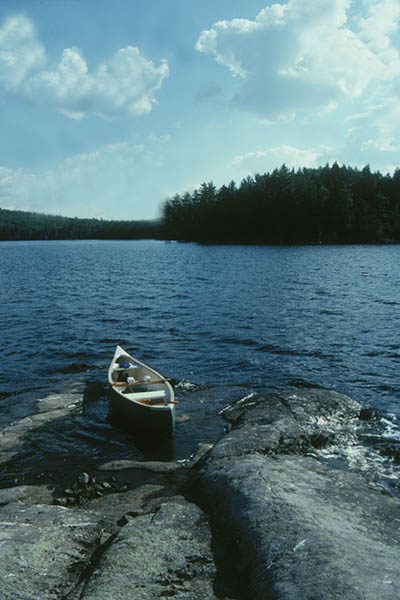 with the same warm reception as the State Land Master Plan. It established a land-use control framework that, like the SLMP, classified lands in the Park based on their characteristics and usage. It also gave the APA regulatory authority to oversee larger commercial and residential development projects and placed restrictions on shoreline development. In its inception, the PLUDP generated hostile opposition toward the APA. Today, while there is general agreement that the APA could use updating and improvements, the siren calls for the Agency to be abolished have largely disappeared.
with the same warm reception as the State Land Master Plan. It established a land-use control framework that, like the SLMP, classified lands in the Park based on their characteristics and usage. It also gave the APA regulatory authority to oversee larger commercial and residential development projects and placed restrictions on shoreline development. In its inception, the PLUDP generated hostile opposition toward the APA. Today, while there is general agreement that the APA could use updating and improvements, the siren calls for the Agency to be abolished have largely disappeared.
That being said, one thing is for certain. Whether you’re a native Adirondacker, a transplant, a seasonal resident, or a weekend visitor…we all agree that the wilderness, wildlife, waters, and communities of Adirondack Park are special and should have some level of protection.
As we celebrate the Adirondack Park’s 125th Birthday, we can be thankful that our forefathers had the foresight to protect this wild and unique region for us to enjoy. Today, the Adirondack Park is unlike any place on the planet. Forever Wild remains the strongest forest protection in the country, and is the reason the Adirondack Park is home to 90 percent of the Northeast’s remaining motor-free wilderness areas and contains a majority of the East Coast’s old growth forests. With its mixture of public and private lands, the Adirondack Park is an example of how nature and people can thrive together. Here’s looking to the next 125…
|

